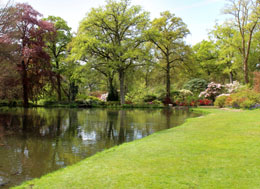Are you planning a Japanese garden and wondering what plants you can use for it? Here's an article that can help you with that.

We're so caught up in our hectic lives, that we seldom get time to unwind and relax. We look for escapes from our busy schedule but rarely find them. The thought of taking a trip away for a couple of days seems appealing, but when it comes to the actual planning and packing and traveling, we prefer the comfort of our homes. There is indeed no place like home. Now think about this, what if you had that much-desired escape right in your backyard? What if you could take a trip into nature's splendor by just opening your back door? Sounds enticing? Then you'll love what I have for you! This article will tell you about Japanese gardens and all the different plants that you can use in it.
What is a Japanese Garden?
Japanese gardens, as the name suggests, is a garden that is created in Japanese style. It follows the basic principles highlighted in Japanese culture: peace, serenity, and tranquility. Nature is the central theme in a Japanese garden. And everything that you use must have an element of nature in it. The history of these gardens states that, at first, they were made as a representation of Buddhism, then the focus shifted to being a place to relax and entertain oneself. Then, with the improvement in gardening techniques, the gardens started flourishing and people who were interested in the designing and maintenance got a boost. Japanese flower gardens have been glorified in numerous paintings and poetry.
Must-haves
- Vantage Point: Almost all Japanese gardens have a natural or constructed platform from which the entire garden can be viewed. This could be a platform in the middle of the house or a window in your house, from which you can see the entire garden.
- Rocks: Stone is an important element in a Japanese garden. Since nature has to be highlighted in such a garden, rocks can symbolize hills or a mountain range.
- Water: The basic idea of a Japanese garden is to magnify with the minimal space that you have. So, having water in your garden can be representation of seas or oceans.
- Bridge and Lantern: A bridge from one part of the garden to the other is also one of the salient features of a Japanese garden. Also, a lantern, made of stone, is often seen. Though some people use it just for decoration, it does serve the purpose of lighting as well.
- Greenery and Color: Another, and probably the most important aspect of a Japanese garden is the display of greenery. It can exude the peace, tranquility, and serenity that it stands for only by using the greenest plants and some shrubs with vibrant flowers to add a dash of color here and there. Evergreen flowering shrubs display the grandeur of nature's bounty to the maximum. Bamboo plants are also used quite often.
Plants and Trees
Given below is a list of plants that you can use to plan your own garden. They have been divided into grass or ground covers, shrubs and bushes, and trees that can be used.
Ground Cover
Shrubs
Trees
Scotch Moss
Bottlebrush Buckeye
Mexican Plum
Mondo Grass
Mahonia
Carolina Buckthorn
Indian Strawberry
Camellia
Himalayan Magnolia
Ground Ivy
Azelia
Burgundy Japanese Maple
Golden Star
Flowering Quince
Japanese Black Pine
Polytrichum
Lily Turf
Tulip Tree
Crowberry
Barberry
Water Oak
Turfgrass
Tea tree
European Beech
Hope this article has inspired you to design a sprawling garden for yourself. It's the best treat you can give yourself and your family. So get your landscaping people to start planning one right away!






 We're so caught up in our hectic lives, that we seldom get time to unwind and relax. We look for escapes from our busy schedule but rarely find them. The thought of taking a trip away for a couple of days seems appealing, but when it comes to the actual planning and packing and traveling, we prefer the comfort of our homes. There is indeed no place like home. Now think about this, what if you had that much-desired escape right in your backyard? What if you could take a trip into nature's splendor by just opening your back door? Sounds enticing? Then you'll love what I have for you! This article will tell you about Japanese gardens and all the different plants that you can use in it.
We're so caught up in our hectic lives, that we seldom get time to unwind and relax. We look for escapes from our busy schedule but rarely find them. The thought of taking a trip away for a couple of days seems appealing, but when it comes to the actual planning and packing and traveling, we prefer the comfort of our homes. There is indeed no place like home. Now think about this, what if you had that much-desired escape right in your backyard? What if you could take a trip into nature's splendor by just opening your back door? Sounds enticing? Then you'll love what I have for you! This article will tell you about Japanese gardens and all the different plants that you can use in it.